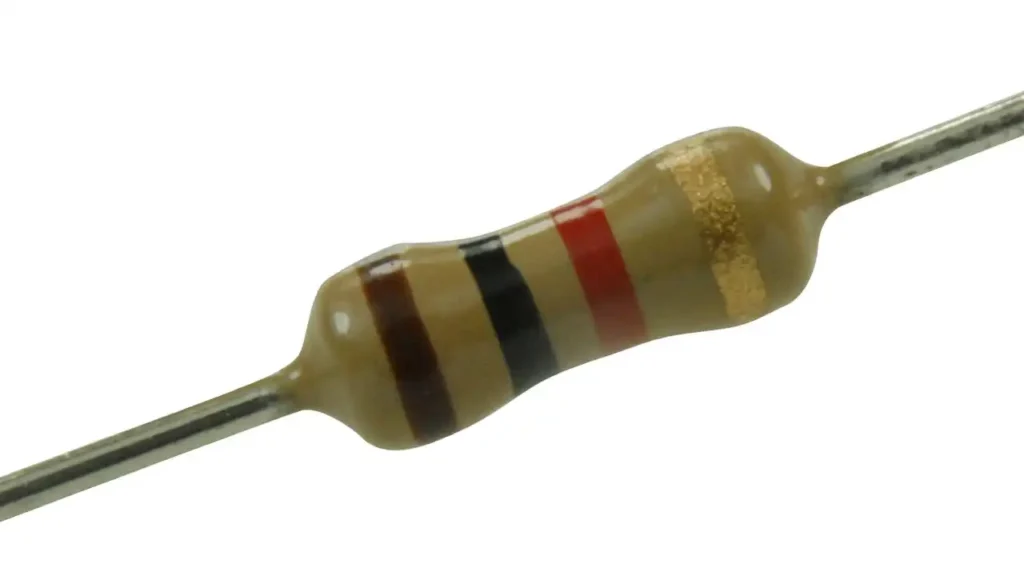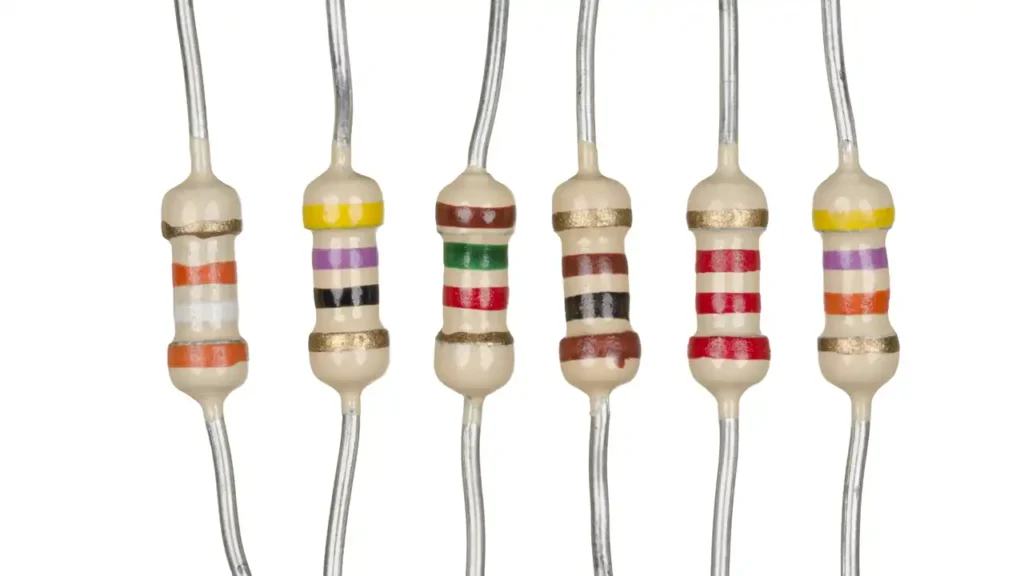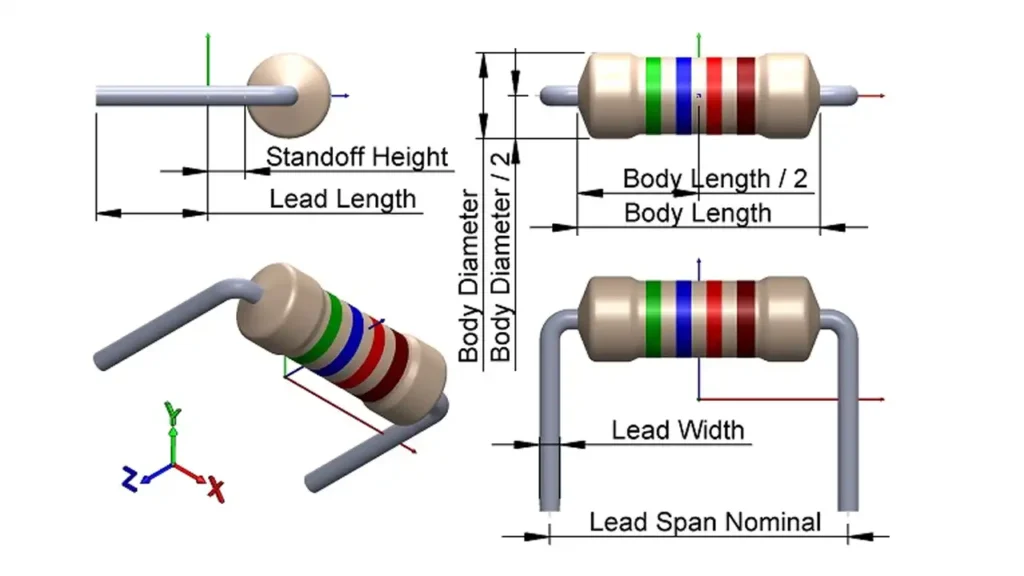Through-hole resistors are a fundamental type of electronic component used to introduce resistance into electrical circuits. These resistors are characterized by their cylindrical shape and lead wires that are inserted through holes in a printed circuit board (PCB). This mounting method, known as through-hole technology (THT), has been a standard practice in electronics for decades.
In this blog post, we will delve deeper into the world of through-hole resistors, exploring their construction, types, applications, and common uses.
What is a Through Hole Resistor?

Through-hole resistors are a fundamental type of electronic component used to introduce resistance into electrical circuits. As the name suggests, they are characterized by their cylindrical shape and lead wires that are inserted through holes in a printed circuit board (PCB).
This mounting method, known as through-hole technology (THT), has been a standard practice in electronics for decades.
What is the Composition of a Through-Hole Resistor?
Through-hole resistors are typically composed of the following elements:
- Body: The main body of the resistor is usually made of one of the following materials:
- Carbon: This is a common material for low-cost resistors.
- Metal film: Offers better precision, stability, and temperature coefficient than carbon resistors.
- Wire-wound: Used for high-power applications due to their ability to dissipate heat effectively.
- Leads: The leads of a through-hole resistor are typically made of tinned copper. These leads are inserted through holes in the printed circuit board (PCB) and soldered to secure the resistor in place.
The specific composition of a resistor can vary depending on its type and intended application. For example, precision resistors may use specialized materials and manufacturing techniques to achieve higher accuracy and stability.
Through Hole Resistor Types

Through-hole resistors are available in various types, each with its own unique characteristics and applications. Here are some of the most common types:
1. Carbon Resistors:
- Construction: Made of carbon granules mixed with a binder.
- Characteristics: Low cost, wide resistance range, moderate precision, and temperature coefficient.
- Applications: General-purpose applications, such as voltage dividers, current limiting, and filters.
2. Metal Film Resistors:
- Construction: Made of a thin metal film deposited onto a ceramic substrate.
- Characteristics: High precision, low temperature coefficient, excellent stability, and low noise.
- Applications: Precision circuits, audio equipment, and instrumentation.
3. Wire-Wound Resistors:
- Construction: Made of a wire wound around a ceramic core.
- Characteristics: High power dissipation, low resistance values, and good temperature stability.
- Applications: High-power applications, such as motor control, power supplies, and audio amplifiers.
4. Precision Resistors:
- Construction: Made using specialized manufacturing techniques to achieve extremely high precision.
- Characteristics: Very low tolerance, excellent stability, and low temperature coefficient.
- Applications: Precision measurement instruments, laboratory equipment, and high-end audio equipment.
5. Variable Resistors (Potentiometers):
- Construction: A type of resistor with a variable resistance element.
- Characteristics: Allow for manual adjustment of resistance.
- Applications: Volume controls, brightness adjustments, and user-adjustable settings.
These are just a few of the many types of through-hole resistors available. The choice of resistor type depends on the specific requirements of the application, such as resistance value, power rating, precision, and temperature coefficient.
Through Hole Resistor Footprint

Footprint refers to the physical layout or outline of a component on a printed circuit board (PCB). For through-hole resistors, the footprint typically consists of two pads, one for each lead.
Standard Footprint Dimensions:
While there can be variations based on specific resistor types and manufacturers, the following dimensions are commonly used for through-hole resistors:
- Pad diameter: 0.062 inches (1.57 mm)
- Pad spacing: 0.1 inches (2.54 mm)
- Lead pitch: 0.1 inches (2.54 mm)
Note: These dimensions are approximate and may vary depending on the specific resistor and PCB design requirements.
Factors Affecting Footprint Design:
- Resistor size: Larger resistors may require larger footprints.
- PCB layout constraints: The overall design of the PCB, including component placement and routing, can influence footprint dimensions.
- Manufacturing tolerances: The accuracy of the PCB manufacturing process can affect the tolerances of the footprint.
Creating Custom Footprints:
If you need a custom footprint for a specific resistor, you can create it using PCB design software. These tools allow you to define the pad dimensions, spacing, and lead pitch based on the resistor’s datasheet or physical measurements.
When designing a footprint, it’s essential to consider the following factors:
- Clearance: Ensure sufficient clearance between the resistor’s leads and other components on the PCB to prevent shorts.
- Solderability: The pads should be positioned and sized to facilitate easy soldering.
- Mechanical stress: The footprint should be designed to minimize mechanical stress on the resistor during assembly and operation.
By following these guidelines, you can create accurate and reliable footprints for through-hole resistors in your PCB designs.
What is the Purpose of a Through-Hole?
A through-hole is a drilled opening in a printed circuit board (PCB) that is used to accommodate the leads of electronic components. These components, such as resistors, capacitors, and transistors, have leads that are inserted through the holes and then soldered to the PCB.
The primary purpose of through-holes is to provide a secure and reliable connection between the component and the PCB. This connection ensures that the electrical signals can flow freely between the component and the rest of the circuit.
Through-hole technology (THT) has been a standard practice in electronics for many years. However, with the advent of surface-mount technology (SMT), which involves attaching components directly to the surface of the PCB, THT has become less common in some applications. Nevertheless, through-hole components are still widely used in certain industries and applications, especially when high power dissipation or mechanical robustness is required.
What Wattage Are Through-Hole Resistors?
The wattage of a through-hole resistor depends on its size and construction. Larger resistors can typically handle higher wattages, as they have more surface area to dissipate heat.
Here are some common wattage ratings for through-hole resistors:
- 1/4 watt: A common rating for general-purpose resistors.
- 1/2 watt: Used for slightly higher power applications.
- 1 watt: Suitable for moderate power levels.
- 2 watts: Can handle higher power levels, often used in audio amplifiers and power supplies.
- 5 watts and above: Used for high-power applications, such as motor control and industrial equipment.
It’s important to select a resistor with a wattage rating that is sufficient to handle the expected power dissipation in your circuit. Exceeding the resistor’s power rating can cause it to overheat and fail.
When choosing a through-hole resistor, always check its datasheet for the specified wattage rating. This information is typically printed on the resistor’s body or included in the manufacturer‘s documentation.
Conclusion
Through-hole resistors are a fundamental component in electronic circuits, providing essential resistance to control the flow of current. With their reliable construction, wide range of types, and versatility in applications, they remain a valuable choice for many electronic designs.
Need high-quality through-hole resistors for your projects? Look no further! [Your Company Name] offers a vast selection of top-tier through-hole resistors, including:
- Carbon resistors
- Metal film resistors
- Wire-wound resistors
- Precision resistors
Our resistors are sourced from trusted manufacturers, ensuring reliability and performance. Whether you’re working on a hobby project, building a prototype, or mass-producing electronic devices, we have the components you need.
Contact us today to discuss your requirements and get started on your next project.